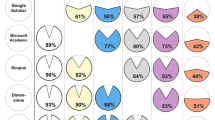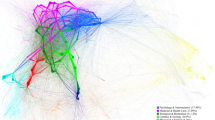Abstract
The humanities are often characterized by sociologists as having a low mutual dependence among scholars and high task uncertainty. According to Fuchs’ theory of scientific change, this leads over time to intellectual and social fragmentation, as new scholarship accumulates in the absence of shared unifying theories. We consider here a set of specialisms in the discipline of history and measure the connectivity properties of their bibliographic coupling networks over time, in order to assess whether fragmentation is indeed occurring. We construct networks using both reference overlap and textual similarity. It is shown that the connectivity of reference overlap networks is gradually and steadily declining over time, whilst that of textual similarity networks is stable. Author bibliographic coupling networks also show signs of a decline in connectivity, in the absence of an increasing propensity for collaborations. We speculate that, despite the gradual weakening of ties among historians as mapped by references, new scholarship might be continually integrated through shared vocabularies and narratives. This would support our belief that citations are but one kind of bibliometric data to consider—perhaps even of secondary importance—when studying the humanities, while text should play a more prominent role.







Similar content being viewed by others
References
Balietti, S., Mäs, M., & Helbing, D. (2015). On disciplinary fragmentation and scientific progress. PloS One, 10(3), e0118,747.
Barrett, A. (2005). The information-seeking habits of graduate student researchers in the humanities. The Journal of Academic Librarianship, 31(4), 324–331.
Bornmann, L., & Mutz, R. (2015). Growth rates of modern science: A bibliometric analysis based on the number of publications and cited references. Journal of the Association for Information Science and Technology, 66(11), 2215–2222.
Boyack, K. W., Newman, D., Duhon, R. J., Klavans, R., Patek, M., Biberstine, J. R., et al. (2011). Clustering more than two million biomedical publications: Comparing the accuracies of nine text-based similarity approaches. PLoS ONE, 6(3), e18029.
Buchanan, G., Cunningham, S. J., Blandford, A., Rimmer, J., & Warwick, C. (2005). Information seeking by humanities scholars. In International conference on theory and practice of digital libraries (pp. 218–229). Springer.
Chen, C., & Song, M. (2017). Representing scientific knowledge. Cham: Springer International Publishing.
Colavizza, G. (2017). The structural role of the core literature in history. Scientometrics, 113(3), 1787–1809.
Colavizza, G. (2018). Understanding the history of the humanities from a bibliometric perspective: Expansion, conjunctures and traditions in the last decades of Venetian historiography (1950–2013). History of Humanities, 3(2), 377–406.
Colavizza, G., Boyack, K. W., van Eck, N. J., & Waltman, L. (2018). The closer the better: Similarity of publication pairs at different cocitation levels. Journal of the Association for Information Science and Technology, 69(4), 600–609.
Collins, R. (1975). Conflict sociology: Toward an explanatory science. New York: Academic Press.
De Solla Price, D. (1970). Citation measures of hard science, soft science, technology, and nanoscience. In C. E. Nelson & D. K. Pollock (Eds.), Communication among scientists and engineers (pp. 3–22). Lexington, MA: Heath Lexington Books.
Evans, J. A. (2008). Electronic publication and the narrowing of science and scholarship. Science, 321(5887), 395–399.
Fry, J., & Talja, S. (2007). The intellectual and social organization of academic fields and the shaping of digital resources. Journal of Information Science, 33(2), 115–133.
Fuchs, S. (1992). The professional quest for truth: A social theory of science and knowledge., SUNY series in science, technology, and society Albany: State University of New York Press.
Fuchs, S. (1993). A sociological theory of scientific change. Social Forces, 71(4), 933–953.
Garfield, E. (1980). Is information retrieval in the arts and humanities inherently different from that in science? The effect that ISI®’s Citation Index for the arts and humanities is expected to have on future scholarship. The Library Quarterly, 50(1), 40–57.
Glänzel, W., & Schoepflin, U. (1999). A bibliometric study of reference literature in the sciences and social sciences. Information Processing & Management, 35(1), 31–44.
Guetzkow, J., Lamont, M., & Mallard, G. (2004). What is originality in the humanities and the social sciences? American Sociological Review, 69(2), 190–212.
Hammarfelt, B. (2011). Interdisciplinarity and the intellectual base of literature studies: Citation analysis of highly cited monographs. Scientometrics, 86(3), 705–725.
Hellqvist, B. (2009). Referencing in the humanities and its implications for citation analysis. Journal of the American Society for Information Science and Technology, 61(2), 310–318.
Henriksen, D. (2016). The rise in co-authorship in the social sciences (1980–2013). Scientometrics, 107(2), 455–476.
Hicks, D. (1999). The difficulty of achieving full coverage of international social science literature and the bibliometric consequences. Scientometrics, 44(2), 193–215.
Huang, Mh, & Yw, Chang. (2008). Characteristics of research output in social sciences and humanities: From a research evaluation perspective. Journal of the American Society for Information Science and Technology, 59(11), 1819–1828.
Hyland, K. (2006). Disciplinary differences: Language variation in academic discourses. In K. Hyland & M. Bondi (Eds.), Academic discourse across disciplines (pp. 17–45). Bern: Peter Lang.
Jones, B. F. (2009). The burden of knowledge and the “death of the renaissance man”: Is innovation getting harder? The Review of Economic Studies, 76(1), 283–317.
Kessler, M. M. (1963). Bibliographic coupling between scientific papers. American Documentation, 14(1), 10–25.
Knievel, J. E., & Kellsey, C. (2005). Citation analysis for collection development: A comparative study of eight humanities fields. The Library Quarterly: Information, Community, Policy, 75(2), 142–168.
Kuhn, T. S. (1996). The structure of scientific revolutions (3rd ed.). Chicago: University of Chicago Press.
Kyvik, S., & Reymert, I. (2017). Research collaboration in groups and networks: Differences across academic fields. Scientometrics, 113(2), 951–967.
Larivière, V., Gingras, Y., & Archambault, E. (2009). The decline in the concentration of citations, 1900–2007. Journal of the American Society for Information Science and Technology, 60(4), 858–862.
Lin, C. S., Chen, Y. F., & Chang, C. Y. (2013). Citation functions in social sciences and humanities: Preliminary results from a citation context analysis of Taiwan’s history research journals. Proceedings of the American Society for Information Science and Technology, 50(1), 1–5.
Linmans, A. J. M. (2009). Why with bibliometrics the humanities does not need to be the weakest link: Indicators for research evaluation based on citations, library holdings, and productivity measures. Scientometrics, 83(2), 337–354.
Nederhof, A. J. (2006). Bibliometric monitoring of research performance in the social sciences and the humanities: A review. Scientometrics, 66(1), 81–100.
Newman, M. E. J. (2010). Networks: An introduction. Oxford: Oxford University Press.
Sparck Jones, K., Walker, S., & Robertson, S. (2000a). A probabilistic model of information retrieval: Development and comparative experiments. Part 1. Information Processing & Management, 36(6), 779–808.
Sparck Jones, K., Walker, S., & Robertson, S. (2000b). A probabilistic model of information retrieval: Development and comparative experiments. Part 2. Information Processing & Management, 36(6), 809–840.
Stone, S. (1982). Humanities scholars: Information needs and uses. Journal of Documentation, 38(4), 292–313.
Talja, S., & Maula, H. (2003). Reasons for the use and non-use of electronic journals and databases: A domain analytic study in four scholarly disciplines. Journal of Documentation, 59(6), 673–691.
Trace, C. B., & Karadkar, U. P. (2017). Information management in the humanities: Scholarly processes, tools, and the construction of personal collections. Journal of the Association for Information Science and Technology, 68(2), 491–507.
Tyrrell, I. R. (2005). Historians in public: The practice of American history, 1890–1970. Chicago: University of Chicago Press.
van Leeuwen, T. (2006). The application of bibliometric analyses in the evaluation of social science research. Who benefits from it, and why it is still feasible. Scientometrics, 66(1), 133–154.
Whitley, R. (1984). The intellectual and social organization of the sciences. Oxford: Oxford University Press.
Williams, P., Stevenson, I., Nicholas, D., Watkinson, A., & Rowlands, I. (2009). The role and future of the monograph in arts and humanities research. Aslib Proceedings, 61(1), 67–82.
Ziman, J. M. (1968). Public knowledge: An essay concerning the social dimension of science. Cambridge: Cambridge University Press.
Acknowledgements
This research has been funded in part by the Swiss National Fund with Grants 205121_159961 and P1ELP2_168489.
Author information
Authors and Affiliations
Corresponding author
Rights and permissions
About this article
Cite this article
Colavizza, G. A diachronic study of historiography. Scientometrics 117, 2117–2131 (2018). https://doi.org/10.1007/s11192-018-2934-0
Received:
Published:
Issue Date:
DOI: https://doi.org/10.1007/s11192-018-2934-0




